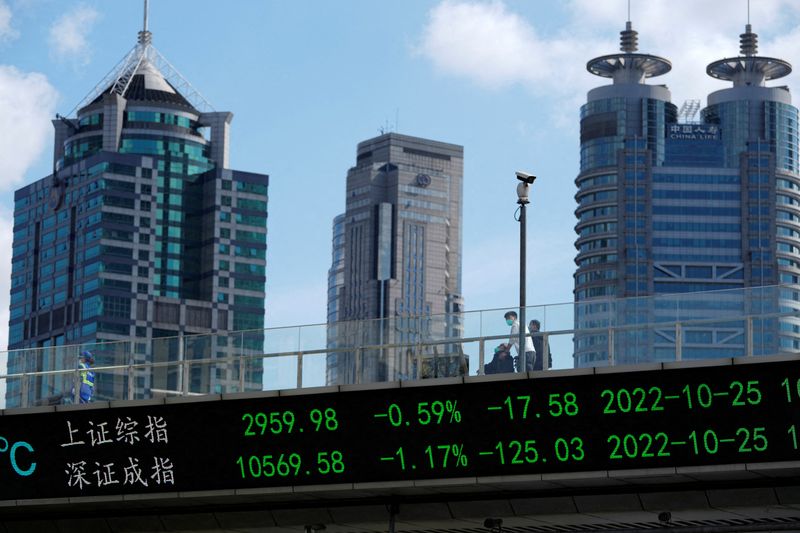Morning bid: Tightest financial conditions this year bite
2023.09.10 18:11

© Reuters. FILE PHOTO: An electronic board shows Shanghai and Shenzhen stock indexes, at the Lujiazui financial district in Shanghai, China October 25, 2022. REUTERS/Aly Song/File Photo
By Jamie McGeever
(Reuters) – A look at the day ahead in Asian markets from Jamie McGeever, financial markets columnist.
Asian markets are set for a nervous open on Monday as worries mount that last week’s equity selloff could accelerate, financial conditions continue to tighten, and investors brace for a raft of economic data from China throughout the week.
There seems to be no obvious market impact from the G20 summit in India, and politically-influenced trading will likely be dominated by U.S.-China tensions. Last week Apple (NASDAQ:)’s 6% slide wiped $180 billion off its market cap on news that Beijing had banned government employees from using iPhones at work.
Broader market sentiment is fragile. The Nasdaq shed 2% last week, and the , MSCI World and Index all fell more than 1%.
Tightening financial conditions from high bond yields and a strong dollar, and unease about the looming lag effects of the Fed’s rate hikes are coming together in what has been historically a notoriously volatile month for stocks.
According to Goldman Sachs’s real-time indexes, financial conditions in China, emerging markets and globally are now the tightest since last November.
The dollar is at a six-month high, Asian currencies are feeling the heat, and traders are on intervention alert – India’s rupee posted a record closing low on Thursday and the Japanese yen, Philippine peso and Thai Baht are at their lowest levels this year.
Currencies may also get direction from a sprinkling of key economic indicators across the region this week – Indian trade and inflation, Australian unemployment, Indonesia retail sales, and Japanese industrial production and machinery orders.
The economic data spotlight this week will shine on China. Beijing often concentrates the release of key indicators into short bursts – often referred to as the ‘Chinese data dump’ – but this one is particularly heavy.
Money supply, loan growth, social financing (a broad measure of credit and liquidity in the economy), retail sales, industrial production, unemployment, house prices and fixed asset investment are all due for release by September 15.
That follows producer and consumer price inflation figures on Saturday that suggest disinflationary pressures are sticky. Annual PPI was negative for the 11th month in a row, and annual CPI rose only 0.1%, undershooting forecasts of a 0.2% increase.
The state of China’s economy will be much clearer by the end of the week, as will the scale of the task facing authorities to provide the necessary monetary and fiscal stimulus to keep Beijing’s goal of 5% GDP growth this year in sight.
But complicating this is the yuan, which is at a 16-year low. Further policy easing will put it under even heavier downward pressure, risking a spiral of FX depreciation, asset market weakness and capital flight.
Here are key developments that could provide more direction to markets on Monday:
– Malaysia industrial production (July)
– Japan money supply (August)
– U.S. 3-year note auction
(By Jamie McGeever; Editing by Diane Craft)








